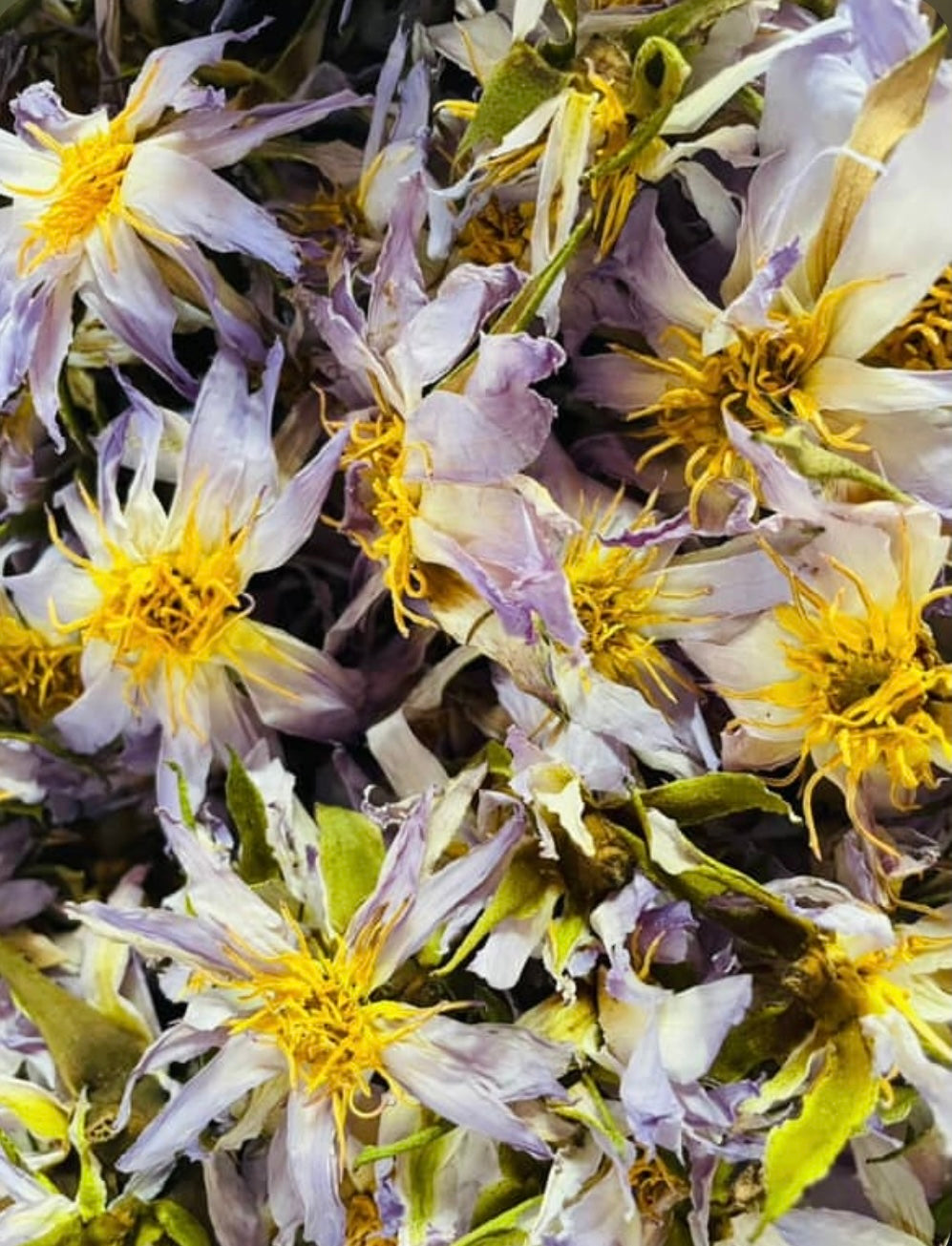
Blue Lotus Collection – Authenticity & Clarity
Share
We know there’s a lot of chatter online about what really counts as “blue lotus.” On Reddit and herbal forums people ask: Is this true Egyptian Blue Lotus or just another waterlily? The short answer is: authentic Nymphaea caerulea (Egyptian blue lotus) is indeed very rare. Conservationists report it’s “incredibly rare” and even “threatened, on the verge of being endangered” due to habitat changes like the Aswan Dam . As a result, many products labeled “blue lotus” today are actually more common blue water lilies. In the words of one Berkeley researcher, “the stuff being sold online is not the same” as the ancient Egyptian lotus . In other words, if you see intensely purple-blue petals on a tea product or oil, chances are they’re from a different Nymphaea species – not the pale, sky-blue N. caerulea of Egyptian lore.
- Genuine Egyptian Blue Lotus is scarce: Modern science confirms it’s become “increasingly rare” in the wild . Ancient Egyptians adored this lily, but today only a few living specimens are kept (for example, UC Berkeley has the only university-grown Egyptian blue lotus in the U.S. ).
- Most “Blue Lotus” on the market is a lookalike: In fact, researchers found that many commercial “blue lotus” products contain non-psychoactive water lilies. These look-alikes may be striking in color, but they lack the unique chemistry of true N. caerulea . As one study notes, the verified Egyptian blue lotus had much higher levels of nuciferine than any random lotus petals bought online, leading to the conclusion that those market samples were just common lilies .
Figure: Real Egyptian Blue Lotus (right) is a delicate pale blue, unlike typical “blue lotus” petals sold online (left). Experts warn “the stuff being sold online is not the same” as true Nymphaea caerulea .
Healing Herbals’ Assurance
We’ve heard these concerns, and we want you to shop with complete confidence. Our Egyptian Blue Lotus petals and extracts are 100% genuine Nymphaea caerulea. We work directly with trusted growers who specialize in this plant, using responsible cultivation practices. Every batch is clearly labeled with its botanical name so you know it’s authentic. We do not cut corners by mixing in other lilies. In fact, scientists like Liam McEvoy (UC Berkeley) emphasize that true blue lotus is a “very specific plant” – and that’s exactly what we deliver.
- Transparent sourcing: We openly share our supply information and partner with ethical farms. Because real N. caerulea is so rare, we’re careful about sustainability. We never label a product “Blue Lotus” without specifying the Latin name and origin.
- Rigorous quality: All Healing Herbals products are tested for purity. We respect the plant’s history and potency. As one report noted, genuine Egyptian blue lotus is prized partly because of its psychoactive alkaloids . We ensure you’re getting the flower you expect, not a substitute.
- Welcoming support: We’re here to answer questions about any bloom. Our customer community (including many Redditors!) values honesty. If you’ve seen posts saying “there’s no true blue lotus on the market,” we want to change that. We stand behind our authenticity – and we explain the differences so you can choose with confidence.
Varieties of “Blue Lotus” – Clearly Labeled
We also want to clear up another point: “Blue Lotus” is a common nickname for several aquatic lilies. For example, the sacred lotus of India (often called Indian or Utapala Lotus) is actually Nymphaea stellata (synonym N. nouchali), and other tropical water lilies might be called “blue lotus” in error. At Healing Herbals we offer multiple blue-lotus-type flowers, but we always use the scientific names and descriptions so you aren’t left guessing.
- Egyptian Blue Lotus (N. caerulea): This is our signature item, true to the name. It’s clearly labeled “Egyptian Blue Lotus” with the Latin name.
- Indian (Utpala) Blue Lotus (N. stellata/nouchali): Also called Sacred Blue Lily of the Nile or Utapala. We list these by name (e.g. N. nouchali var. stellata) and origin so you know it’s a different species.
- Other Blue Water Lilies: We may carry strains like Thai Blue Lotus or Blue Waterlily (different Nymphaea species) – each product page spells out exactly which lily it is.
In short, we respect the rich tradition of blue lotus while cutting through the confusion. You’ll find a genuine Egyptian Blue Lotus and a range of other blue lilies in our collection, all with transparent labeling. Trust Healing Herbals to bring you real botanicals with a warm, honest touch – because authenticity is at the heart of healing.
Sources: Modern research confirms the rarity of true N. caerulea and the prevalence of look-alikes . We draw on these studies and community knowledge to ensure our customers get the real deal.
